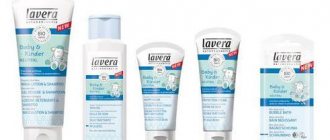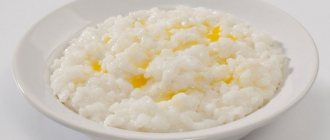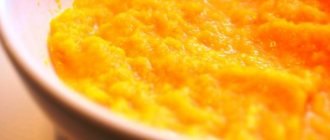For a child in the initial period after birth, breast milk is the main nutrition. But, for those who are not able to give him this method, an analogy has been invented in the form of milk mixtures. A completely new level is the introduction of complementary foods. The recommended age at which complementary feeding should be introduced is 6 months, however, for medical reasons, the period may be shifted.
Many experts have various discussions on this matter, and there is no definite answer as to which subtype is best to start with. Many believe that it is ideal to introduce vegetable purees from cabbage, beans, carrots and much more, while others adhere to the principle of porridge first. These can include a wide variety, ranging from barley to regular buckwheat. Of course, the decision here remains with each parent individually and with the doctors who examine the child in the clinic.
Speaking of porridges, the best option remains a one-ingredient dairy-free porridge, because it has a simple composition that becomes more complex as the baby gets used to it. You can see the feeding instructions on each package and choose the appropriate option for yourself. The absence of dairy components allows you to eliminate an allergic reaction, because milk is considered a strong allergen. Well, don’t forget about the ease of use of quickly prepared cereals, which speeds up the feeding process for many mothers. That is why you should know about the best representatives of different options of cereals for the first feeding. In this case, you should focus on several points:
- Compound;
- Price;
- Market demand for similar products;
- Reviews from other mothers;
- Experts' opinion.
Benefits of cereals for first feeding
In many articles you can read that for the first complementary feeding it is best to use cereals that can be prepared quickly. The advantages of this method are the following factors:
- All manufacturers enrich their products with vitamin and mineral complexes;
- You don't need to spend a lot of time cooking;
- The child's stomach quickly digests the porridge;
- Homogeneous consistency that does not change when cooled;
- Do not contain impurities that can harm the health of the child;
- All components are natural;
- All cereals undergo quality control;
- Reduced viscosity, making components easier to swallow.
Thanks to these advantages, many mothers resort to using special cereals. And now almost every one of them uses only industrial products.
Which porridge to choose: milk or dairy-free
When the child has grown up and the time has come to decide what complementary feeding should be - milk or dairy-free cereals, this issue becomes the main subject of discussion.
Qualified assistance can only be provided by a pediatrician, who will make a decision based on objective data (the state of the child’s health, rate of weight gain, already observed allergic reactions, etc.).
As a rule, dairy-free cereals are recommended as the first complementary food. And only after the child has adapted to the new dish can milk porridge be introduced into the diet. This sequence is due to the presence of cow's milk proteins in milk porridges. In children with food hypersensitivity, these substances can provoke allergic reactions, so it is better to introduce milk porridges after dairy-free ones, when the immune system is already “accustomed” to cereals and is less likely to react violently to new components.
The best porridge manufacturers
Today in the market of our country you can find several leaders, among which 5 main ones stand out:
- Heinz. This company has been demonstrating quality products for 25 years. She herself is from America, but there is a plant in Stavropol. The products are considered premium and purchased in our country.
- Nestlé. Manufacturer from Switzerland. It has also been operating in our country for more than 25 years and the production factory is located in Vologda. The main characteristics are pleasant taste and good composition.
- Progress. Popular models from manufacturers are continued by this brand from Russia. Since 2000, he began his development with the FrutoNyanya brand of baby food. The production is located in Lipetsk and is equipped with the latest technologies. Many buyers note the good consistency and taste characteristics, and the reasonable price allows you to replace imported brands with your own.
- Fleur Alpin. This company is rightfully included in the category of the best manufacturers, because the food is not only made from natural products, but also belongs to the highest quality class. There is a high price here, which reduces the level of purchases, but, due to the good composition and completely organic agricultural components, the company finds its customers.
- Urbis. This is a company from Israel, but it can be found in our state for more than 20 years. Most of all, the brand puts effort into producing dairy-free porridges.
And in the case when you don’t know which brand is better to buy porridge, then it’s worth talking a little about the categories of dairy-free porridges for the first feeding. These include:
- Hypoallergenic;
- Gluten-free;
- Ready to eat.
Each of these categories has its own representatives, but this ranking will highlight several leading products from each line.
It is important to remember that you should start introducing porridge with buckwheat and rice.
Why is it better to start complementary feeding with porridge?
The preferred first complementary food product is porridge. This is due to the high nutritional value of cereals, in addition, it is a source of fiber, vitamins and minerals, which significantly complements breast milk and formula for artificial feeding. Buckwheat, corn or rice dairy-free porridges are well suited for feeding infants and can be introduced into the menu from 4–5 months of age. How to prepare porridge for the first feeding? This is a very important practical question. You can purchase a specialized commercially produced baby food product, or you can prepare the porridge yourself at home. Experts are unanimous in preferring the first option. Using ready-made instant porridges, you get multiple advantages over self-prepared ones.
The best hypoallergenic cereals
Of course, when seeing new products in stores, parents must be aware that introducing a new component into the diet can cause an adverse reaction in the form of an allergy. Therefore, it is best to start with a minimum and introduce a little at a time, and then monitor the child’s well-being. This habituation must occur over a period of at least 7 days.
If red spots appear on the skin or the child feels itching, it is better to stop the administration process. And to reduce side effects, many mothers prefer to buy a hypoallergenic type of cereal. They are indispensable for those who have serious problems with sensitivity.
Babysitter
This one-component product is known to everyone due to its good quality. The popularity of the models here is also due to the fact that it is approved for use from four months of age. The brand from Israel specializes only in these types of porridges, and you cannot find any harmful components in the form of salt, fructose, preservatives and many others. The composition includes a mineral and vitamin complex, which allows for a pleasant taste sensation. The number of servings per pack is approximately 21.
Babysitter first feeding porridge
Advantages:
- Natural composition;
- Optimal number of servings;
- Pleasant taste.
Flaws:
- Overpriced.
Nestlé
Budget brands of cereals can start with this option. The company has earned the approval of not only mothers, but also many qualified professionals. The composition here is also completely natural, but gluten may be present due to the form of production. This means that when a baby has an intolerance to such a component, it is better not to consume this porridge.
Nestlé first feeding porridge
Advantages:
- Good price;
- Good taste parameters.
Flaws:
- It is impossible to say for sure that it is gluten free.
Fleur Alpin
This list also includes dairy-free, hypoallergenic products that are considered high quality. There are no impurities here, which has been verified by professional experts. It is suitable for consumption from four months and has good taste. Many mothers note that when cooked, it forms a homogeneous and light consistency.
Fleur Alpin first feeding porridge
Advantages:
- No harmful additives;
- Does not form lumps;
- Good taste.
Flaws:
- Quite a high price.
What types of baby cereals are suitable for first feeding?
It turns out that not all cereals can be given to babies, since some of them can do more harm than good to their fragile digestive system. Therefore, it is important for young mothers to know which cereals can be given to a child at 6 months, and which ones are better offered at an older age.
Gluten-free cereals are the best option for feeding a 6-month-old baby, as they do not cause digestive problems.
Gluten is a complex protein of plant origin found in a large number of cereals. It is difficult to digest not only in babies 6 months old, but also in older children. It's all about the peculiarities of the development of the enzymatic function of the gastrointestinal tract. Difficulty digesting gluten results in increased gas, bloating, or abdominal pain. Moreover, sometimes problems with digesting this protein do not go away with age, but last throughout life due to a hereditary disease known as celiac disease. For this disease, a special diet is prescribed and treatment is required. Gluten is also often called gluten.
Cereals that do not contain gluten include:
- corn,
- rice,
- buckwheat
List of cereals that contain gluten:
- millet,
- millet,
- rye,
- oats,
- barley.
It follows that the introduction of complementary foods from 6 months is possible with three types of porridges: corn, rice and buckwheat.
But this does not mean that we have determined the best diet for a 6-month-old baby. Porridge for a 6-month-old child should be selected individually, taking into account the process of its absorption. For example, if the baby suffers from unstable stools, then complementary feeding should be started with rice or corn porridge. If you have constipation, you should exclude foods made from rice cereal from your diet. In such cases, preference is given to buckwheat, which is rich in fiber and can also stimulate digestion.
It is worth noting that buckwheat porridge is quite nutritious and contains a large amount of iron and mineral salts, and this provides considerable benefits to children suffering from iron deficiency anemia.
Lure. Porridge. We cook ourselves
https://youtu.be/8VgtiDCGPxQ
Gluten free porridge
Gluten is a substance that is found in many types of cereals. It can usually be found in semolina, oatmeal and pearl barley. Why shouldn’t small children eat such cereals? There is a danger here in the deterioration of the stomach and the appearance of allergic reactions. Usually, with contraindications, skin rashes appear a few weeks after the start of complementary feeding. Also, if a child loses his appetite or his sleep is disturbed, then it is worth resorting to abolishing these types of cereals. It is best to start this kind of complementary feeding at 8 months.
Vinny
The company is just gaining its distribution, but already has fans among many parents. It is one of the inexpensive producers of cereals, but the product has a good composition and is enriched with a vitamin and mineral complex. You won't find gluten, sugar, salt or other additives here. If you don’t know how to cook it, then it’s worth remembering that it doesn’t require cooking.
porridge for Winnie's first feeding
Advantages:
- Good price;
- High-quality composition;
- Does not cause allergies.
Flaws:
- The brand is new among competitors;
- Lumps may occur during cooking.
Baby
Single-component products belong to a premium brand and contain an optimal combination of vitamins and minerals. One of the disadvantages is the high cost, but it completely exhausts itself due to the presence of good characteristics.
Bebi first feeding porridge
Advantages:
- Enriched with a large amount of vitamins and minerals;
- Suitable for children who have allergy problems;
- Does not form lumps.
Flaws:
- High price.
Heinz
In the event that you do not know which product is best to buy, then you should resort to this option. Most experts today recommend this brand because it has established itself as a good and reliable manufacturer. The composition does not contain any unnecessary components such as sugar, salt and preservatives. It is enriched with a vitamin and mineral complex, and is ready for use from four months. Its characteristics allow it to be considered the best choice, and its attractive price will allow you to easily purchase it for complementary feeding.
Heinz first feeding porridge
Advantages:
- Does not cause allergies;
- Enriched with vitamin-mineral complex;
- The best option;
- Recommended by professionals;
- Good price.
Flaws:
- Not detected.
How and when to introduce the first porridge to a baby's complementary foods
In this case, several scenarios are possible: if the child is not gaining weight well, has unstable or loose stools, and the baby often spits up, then, in this case, it is recommended to start getting acquainted with porridge. In addition, sometimes, when the time to try the first food falls during the cold season, when there are few fresh vegetables, which rarely cause allergic reactions, the pediatrician may recommend starting complementary feeding with cereals. In other cases, the first complementary feeding should consist of vegetable purees, and only after at least 3-4 weeks can you try to expand the child’s menu and introduce him to some new product or dish. The optimal time for introducing complementary foods is 5.5-6 months for children who are breastfed, and 4.5 months for bottle-fed children. Just like vegetable puree, you should start trying cereal dishes with one teaspoon a day, gradually increasing the dose.
Which first porridge is best for complementary feeding? Gluten-free foods should be included in your child’s diet. Gluten, or it can also be called gluten, is a plant protein that is difficult to digest by children six months old. As a result, the child may experience bloating, abdominal pain, and increased gas production.
Cereals that contain gluten include rye, wheat, barley, oats, and millet . They are not recommended for use as a first course for a baby.
Allowed foods include rice, buckwheat and corn . Let's look further at the features of each.
Porridges, ready to eat
And for many, the selection criteria come down to ease of preparation, or rather, the need to only heat the product. Such cereals can now be found on the counter of any store, and they find their relevance precisely for those people who started complementary feeding with fruit and vegetable purees. The consistency here is soft and the taste is quite pleasant.
Thanks to the addition of various fruits, it has an interesting taste and can be not only healthy, but also satisfying. The advantage of such porridges is that they are already completely prepared, and you can take them with you even for a walk without opening them. The two companies in greatest demand here are FrutoNyanya and Hipr.
Hip
This product is ready for use for children aged six months and older. In addition to cereals, there may also be an addition of various fruits, as well as crushed cookies. But, if you started complementary feeding only with porridge, then it is better not to abuse the rapid introduction of this type of complementary feeding. For convenience, manufacturers produce products in glass jars with a volume of up to 200. Many buyers note the porridge due to the good combination of price and quality and the absence of harmful components. It also has good functionality in the form of taste and pleasant consistency.
porridge for first feeding Hipr
Advantages:
- Composition of natural ingredients;
- Good taste.
Flaws:
- Small can volume;
- Suitable only for those who continued feeding after fruit milk.
FrutoNanny
If you do not know how to choose porridge to start complementary feeding, then it is better to resort to this option. The company produces both dry porridges for cooking and ready-made ones. It is the second option that has gained great popularity among many buyers. The products in the jar are perfect for complementary feeding starting from six months, and there are no chemical components in the composition. The production volume is 250 ml, and the price is quite reasonable.
porridge for first feeding FrutoNyanya
Advantages:
- Good price;
- Recommended brand;
- Good composition;
- Convenient packaging.
Flaws:
- It is recommended only for those people who have already introduced fruit puree into their baby’s complementary foods.
Practical advice for starting complementary feeding
Start introducing a new food in the morning, when the baby is hungry and more willing to respond to the food offered. During the day, carefully monitor possible reactions; most often, negative effects appear in the first 3 hours after feeding. Initially, any new product is introduced in a volume of 1 teaspoon, so at first cook in a minimal amount. Remember that this is a perishable food, and at each subsequent meal it is necessary to dilute a fresh portion. Using ready-made instant cereals has another advantage - the mother herself can change the degree of thickness of the finished dish, varying the proportions of dry and liquid parts.
How much does the dairy-free cereal option cost?
The selection criteria for many buyers begin primarily with the price category. If you choose based on price, then be prepared for the fact that the quality will not be very good. It is better to evaluate not only these parameters, but also the composition, as well as customer reviews. The average price is in the range of 100-200 rubles. But all the above product options with their prices are presented in the table below.
| № | Name of product | Cost, rub. |
| The best hypoallergenic options | ||
| 1 | Babbie Sitter | 350 |
| 2 | Nestlé | 120 |
| 3 | Fleur Alpin | 220 |
| Gluten Free Options | ||
| 1 | Vinnik | 70 |
| 2 | Baby | 120 |
| 3 | Heinz | 90 |
| Ready-to-eat options | ||
| 1 | Hip | 95 |
| 2 | Frutonyanya | 70 |











